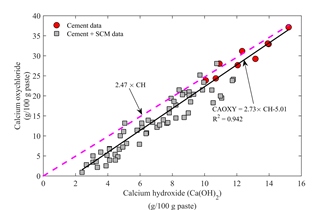Calcium oxychloride formation in pastes containing supplementary cementitious materials: Thoughts on the role of cement and supplementary cementitious materials reactivity
DOI:
https://doi.org/10.21809/rilemtechlett.2016.7Keywords:
deicing salts, calcium oxychloride, differential scanning calorimetry, thermogravimetric analysis, thermodynamic analysisAbstract
Over the last decade many concrete pavements in North America have begun to show excessive damage at the joints. This damage appears to be due to two primary causes: classic freeze-thaw damage due to local saturation caused by the pooling of water at the joints, and formation of an expansive phase known as calcium oxychloride due to a reaction between chloride-based deicing salts and calcium hydroxide in concrete. This letter explores the formation of calcium oxychloride in cementitious matrices based on constituent materials and mixture compositions. Low temperature differential scanning calorimetry and thermogravimetric analysis were used to quantify the amount of calcium oxychloride and calcium hydroxide, respectively. Thermodynamic modeling was used to predict calcium hydroxide contents from the constituent material compositions. It is shown that calcium oxychloride contents are well correlated with calcium hydroxide contents in cementitious pastes. Supplementary cementitious materials, such as fly ash and slag, can reduce calcium oxychloride formation by reducing the amount of calcium hydroxide. Complexities in the determination of reactivity of supplementary cementitious materials based on their replacement level and different water-to-cement ratios are discussed. Although it is clear that supplementary cementitious materials are beneficial in reducing calcium oxychloride formation, additional analysis tools are needed to more accurately quantify the specific mechanisms (such as dilution, pozzolanic or hydraulic reaction, changes in cement hydration) that result in the beneficial aspects of each supplementary cementitious material.

Downloads
Published
How to Cite
Issue
Section
License
Authors retain copyright of the articles published in RILEM Technical Letters and grant the journal the right of first publication with open access. The work is simultaneously licensed under Creative Commons Attribution 4.0 International License (CC BY 4.0) that allows others to share and adapt the work under the following terms: 1) a proper attribution is given in a form of bibliographic record with the DOI link directing to RILEM Technical Letters; 2) a link to the license is provided; 3) the changes (if any) are indicated.









